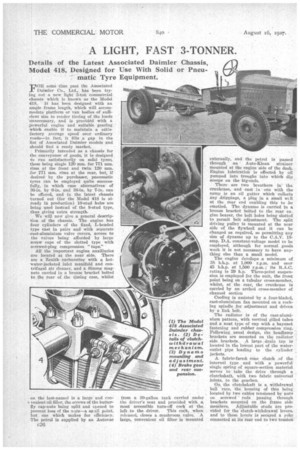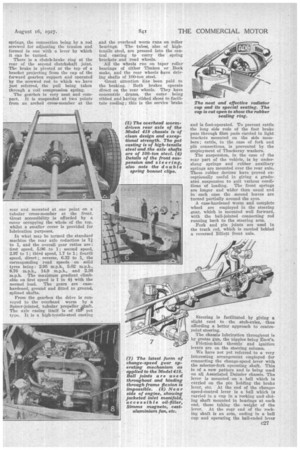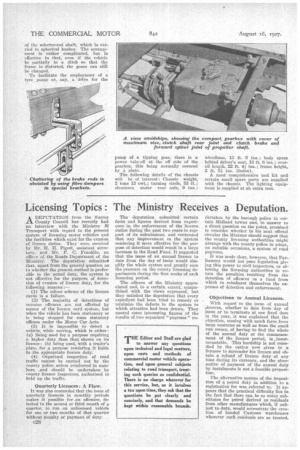A LIGHT, FAST 3-TONNER.
Page 48

Page 49

Page 50

If you've noticed an error in this article please click here to report it so we can fix it.
Details of the Latest Associated Daimler Chassis, Model 418, Designed for Use With Solid or Pneumatic Tyre Equipment,
OR settle time past the Associated ,_12 Daimler Co., Ltd.,. has been trying out a new light 34on commercial chassis which is known as the Model 418. It has been designed with an ample frathe length, which will accommodate platform or van bodies of sufficient size to render tiering of the loads unnecessary, and is provided with a powerful engine and suitable gearing which enable it to maintain a satiafactory average speed over ordinary roads—in fact, it fills a gap in the list of Associated Daimler models and should find a ready market. Primarily intended as a chassis for the conveyanee of goods, it is designed to run satisfactorily on solid tyrds, these being single 120 mm. for 771 mm. rims at the front and twin 120 mm. for 771 mm. rims at the rear, but, if desired by the purchaser, pneumatic tyres can be employed quite suecessfully, in which case alternatives of 36-in. by 6-in. and 38-in. by 7-in. can be offered, and in the latest chassis turned out (for the Model 418 is already in production) 10-stud hubs are being used instead of the 8-stud type, thus giving 'extra strength. We will DOW give a general description of the chassis. The engine has four cylinders of the fixed, 1J-headed type cast in pairs and with separate cast-aluminium valve covers, access to the valves being afforded by large screw caps of the slotted type with screwed-plug compression "taps." All the important engine auxiliaries are located at the near side. There are a Zenith carburetter with a hotwater-jacketed inlet manifold and centrifugal air cleaner, and a Simms magneto carried in a bronze bracket bolted to the rear of the timing case, whilst on the last-named is a large' and con+ venientull_filler. the aerews of the butterfly cap-nuts being split and opened to prevent loss of the nuts—a smell point. but one which makes for efficiency. The petrol is supplied by an Autos-ac from a 20-gallon tank carried .under the driver's seat and provided with a most accessible turn-off cock at the
left to the driver. This cock, when released, closes a mushroom valve. A large, convenient oil filter is mounted externally, and the petrol is passed through an Auto-Klean strainer Mounted at the engine side of the dash. Engine lubriCatioil is effected by oil pumped into troughs into which dip scoops on the big-endS.
There are two breathers in the Crankcase, and cast in one with the sump is an oil gutter . which ' collects any dripping's, a plug in a Small well at the rear end enabling this to be emptied. The dynamo is carried in a bronze bracket bolted to the rear er, gine bearer, the bolt holes being slotted to permit belt adjustment. The split driving pulley is mounted at the near side of the flywheel and it can be changed as required, so permitting any size of dynamo up to the C.A.V. 18amp. D.A. constant-voltage model to be employed, although for normal goods work it is not necessary to have anything else than a small model. The engine develops a minimum of 38 b.h.p. at 1,000 r.pAn. and over 45 b.h.p. at 1,500 r.p.m.; its R.A.C. rating is 29 h.p. Three-point suspension is employed for the unit, the front point being on a tubular cross-member, whilst, at the rear, the crankcase is carried by an arched cross-member of channel section Cooling is assisted 'by a four-bladed, east-aluminium fan mounted on a rocking spindle for adjustment and driven by a 'ink belt. The radiator is of the cast-aluminium pattern, with vertical gilled tubes and a neat type of tap with a bayonet fastening and rubber compression ring. Following, usual design, the headlamp brackets are mounted on the radiator side brackets. A large drain tap is located in the lowest part of the wateroutlet pipe leading to the cylinder
jackets. •
A fabric-facedi cone clutch of the internal .type and with a powerful single spring of square-section material serves to take the drive through a Clutchshaft, with two fabric universal
joints,. to the gearbox. ,
• On the dutehshaft is a, withdrawal ball race, the housing of this being located by two cables tensioned by nuts on screwed rods passing through brackets mounted on the frame side members. AdjuStable studs are provided fo the' clutch-withdrawal levers, and to these levers is secured a yoke connected at its rear end to two tension'
springs, the connection being by a rod screwed for adjusting the tension and formed in one with a lever by which it can be turned.
There is a clutch-brake ring at the rear of the second clutchshaft joint. The brake is pivoted at the top of a bracket projecting from the cap of the forward gearbox support and operated by the screwed rod to which we have just referred, the pull being taken through a coil compression spring.
The gearbox is very neat and compact. It is suspended at two points from an arched cross-member at the rear and mounted at one point on a tubular cross-member at the front. Great accessibility is afforded by a cover occupying the whole of the top, whilst a smaller cover is provided for lubrication purposes.
In what may be termed the standard machine the rear axle reduction is 7i to 1, and the overall gear ratios are : first speed, 5.06 to 1; second speed, 2.97 to 1; third speed, 1.7 to 1; fourth speed, direct; reverse, 6.32 to 1, the corresponding road speeds on solid tyres being : 2.95 m.p.h., 5.02 m.p.h.. 8.76 m.p.h., 14.9 m.p.h., and 2.36 m.p.h. The maximum gradient climbable on first speed is I. in 4iwith the normal load. The gears are casehardened, ground and fitted to ground, splined shafts.
From the gearbox the drive is conveyed to the overhead worm by a Spicer-jointed, tubular. propeller „abaft. The axle casing itself is of tiff pot type. It is a high-tensile-steel casting
and the overhead worm runs on roller
bearings. The tubes', also of hightensile steel, are pressed into the central casting to carry the spring brackets and road wheels.
All the wheels run on taper roller bearings of either Timken or Bock make, and the rear wheels have driving shafts of 100-ton steel.
Great attention ha a been paid to the braking. Both brakes operate direct on the rear wheels. They have concentric drums, • the outer being ribbed and having ribbed shoes to facilitate cooling; this is the service brake and is foot-operated. To prevent rattle the long side rods of the foot brake pass through fibre pads carried in light brackets mounted on the ,side members; rattle, in the ease of fork nod pin connections, is prevented by the employment of Thackeray washers.
The suspension, in the case of the rear part of the vehicle, is by underslung springs and rubber auxiliary springs are mounted over the rear axle. These rubber devices have proved exceptionally useful in giving a graduated suspension to snit various conditions of loading. The front springs are longer and wider than usual and in each case the second leaves are turned partially around the eyes.
A case-hardened worm and complete wheel are employed in the steering gear, which is mounted well forward, with the ball-jointed connecting rod running back to the steering arm.
Fork and pin joints are used in the track rod, which is carried behind a reversed Elliott front axle.
Steering is facilitated by giving a slight cant to the stub-axles, thus affording a better approach to centrepoint steering.
The chassis lubrication througbout is by grease gun, the nipples being Enot's. Friction-held throttle and ignition levers are on the steering column.
We have not yet referred to a very interesting arrangement employed for connecting the change-speed lever with the selector-fork operating shaft. This is of a new pattern and is being used on all Associated Daimler chassis. The lever is mounted on a ball which is carried on the pin holding the brake /ever, etc. At the end of the changespeed-control lever is a ball which is carried in a cup in a rocking and sliding shaft mounted in bearings at each end, these taking the weight of the lever. At the rear end of the rocking shaft is an aim, ending in a ball cup and operating the ball-ended lever
of the selector-rod shaft, which is carried in spherical bushes. The arrangement is rather complicated, but is effective in that, even if the vehicle be partially in a ditch so that the frame is distorted, the gears can still be changed.
To facilitate the employment of a tyre , pump or, say, a drive for the pump of a tipping gear, there is a power take-off at the off side of the gearbox, this being normally covered by a plate.
The following, details of the chassis will be of interest: Chassis weight, 2 tons 13 cwt.; turning circle, 53 ft. ; clearance under rear axle, 9 ins. ; wheelbase, 13 ft. 6 ins. ; body space behind driver's seat, 13 ft. 6 ins.; overall length, 22 ft. 41 ins.; frame height, 2 ft. 5-1 ins. (laden).
A most comprehensive tool kit and certain small spare parts are supplied with the chassis. The lighting equip ment is supplied at an extra cost, •












































































































